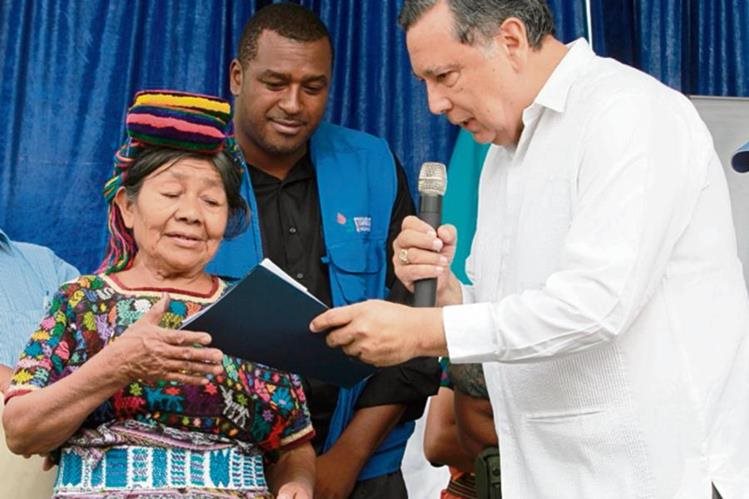By: Monti Aquirre, Latin America Program Director
A ceremony to honor Mother Earth was the first thing the Maya Achí did when they learned their first reparations checks were going to be delivered. As I’ve seen in other ceremonies, they burned chocolate, bread, cinnamon, water, sugar, tobacco, flowers and beer in honor of those massacred to make way for the Chixoy Dam.
On October 15, Juan Alfonso Cifuentes Soria, the new Vice-President of Guatemala, delivered checks in total of $11,205 to 120 families from Pacux and Río Negro, who were among those most impacted by construction of the dam. The first check went to Teodora Chen, a massacre survivor. The next batch of checks will go to 206 families in Chicruz. In total, 33 communities will be paid individual compensation of $22,183,077.30.
Carlos Chen, a principal leader driving the reparations process, said, “Although it has taken many years to get reparations, we are very happy today.” I met Carlos in São Paulo, Brazil in 1999 during the World Commission on Dams (WCD) regional consultation. On the day Carlos spoke to the WCD commissioners and about 500 people about the circumstances of horror under which the dam was built, he also asked International Rivers to help them get reparations. For us, it has been an honor to work with the Maya Achí and other NGOs to make this possible.
Some families had never opened a bank account, but yesterday they did to deposit the checks. Checks are written in the name of the husband and wife. “We wanted to ensure that women can also make decisions about how to spend the funds,” said Carlos.
After some 20 years, the persistence of the Maya Achí has paid off. But their long and painful journey to attain justice has forced them to demonstrate how they lived before the dam, what happened during dam construction, what the living situation was for those who survived the massacres, and what they wanted now.
A legally binding reparations agreement was finally signed on October of 2014 between the communities and the government of Guatemala, but it took one more year for the first checks to arrive.
The new vice-president, Fuentes Soria, said, “the coffers are in pretty bad shape…we made a great effort (to deliver funds now), but the State stopped getting taxes and there are no resources.”
The World Bank and the Inter-American Development Bank (IDB), financiers of the project, made payment of the reparations a condition of $550 million in loans made to Guatemala in early October because the country had breached the agreement to compensate Chixoy Dam-affected peoples. The news added extreme pressure to the Ministry of Finance at a time when it was discussing the sources of funding for the 2016 budget.
In turn, both banks – which for many years did very little to take responsibility for supporting a project that brought about so much death and damage – were instructed by the US Congress in its 2014 US Consolidated Appropriations Bill, to “report … on the steps being taken by such institutions to support implementation of the April 2010 Reparation Plan for Damages Suffered by the Communities Affected by the Construction of the Chixoy Hydroelectric Dam in Guatemala.”
Besides individual compensation, additional funds will be provided for land purchase, economic projects, programs for psychological health and reconstruction of historical memory, cultural and social programs, and environmental plans to mitigate impacts on the Chixoy River basin.
Due to the pressure of communities, electricity is now delivered to their villages. “We can now enjoy a cold beer at home,” said Carlos. “We still need potable water in most villages, but we are working on that.” I am accustomed to Carlos’ pauses in the way he speaks, which I always attributed to the extreme pain he has suffered since his immediate family was massacred. But this time I could feel he was happy.
Photo: Teodora Chen, massacre survivor, receives the first check for reparations | Photo by: La Prensa Libre

